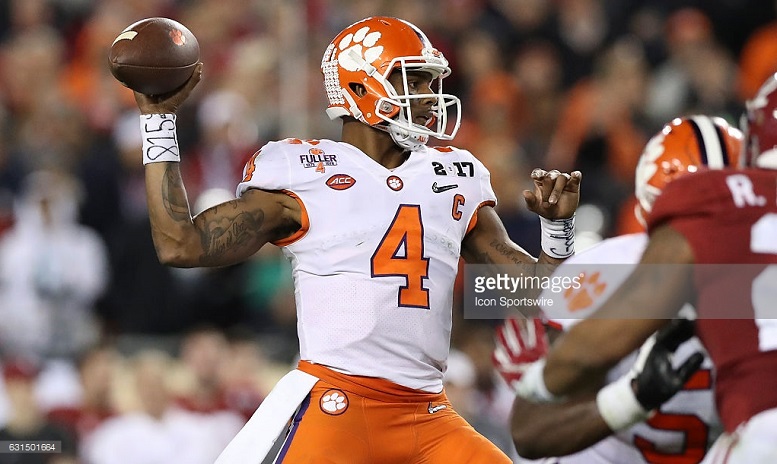As you should know by now, our attention has now shifted to the 2017 NFL Draft as it relates to the prospects. From now until the draft takes place, we hope to profile as many draft prospects as we possibly can for you. Most of these player profiles will be centered around prospects the Pittsburgh Steelers are likely to have interest in while a few others will play top-ranked players.
Today, we will kick off our profiles with a breakdown of Clemson quarterback Deshaun Watson.
Clemson QB Deshaun Watson #4 6’2” 207lbs
Bio:
– Career Passing: 35 Starts, 67.4% Completion Rate, 10,168 Passing Yards, 90 TD 32 INT
– Career Rushing: 435 Carries, 1934 Yards (4.4 Avg), 26 TD
– Heisman Voting: 3rd in 2015, 2nd in 2016
– 2017 College Football Playoff Champion and Offensive MVP
The Good:
– Natural Leader and Winner: In three seasons at Clemson, Watson finished with a 32-3 record as a starter, including two National Championship appearances.
– Clutch: Watson rises to the occasion in the biggest moments. He threw for over 400 yards in both of his National Championship appearances, with 7 TDs and only 1 INT. Additionally, in 2016, Watson led Clemson to 4th quarter comeback victories against No.1 Alabama, No.3 Louisville and No.12 Florida State; as well as an overtime victory against NC State.
– Playmaking Ability: Several times a game, when things didn’t go according to plan, Watson was able to step-up and make a play. He demonstrated this skill both subtly (e.g. avoiding a sack and throwing the ball away) and spectacularly (e.g. off-balance, cross-field touchdown pass with pressure in his face). Some of these plays are shown below.
– Throwing Mechanics: Overall, Watson has a smooth, compact and over-the-top delivery. Very efficient motion that is well-suited for throwing within the confined spaces of an NFL pocket. Footwork is generally good; throws with a solid-base and balanced posture. He occasionally over-strides causing the ball to float and sail; however, this is a fixable defect that should be corrected with NFL coaching.
– Mobility: Although he is not typically an explosive, big-play runner, Watson is a constant threat in the run game. He frequently picks up first downs and extends plays with his feet, forcing defenses to commit a player to “spy” responsibilities.
– Chemistry: Watson had great chemistry with his receivers and coaches. He regularly completed difficult Back-Shoulder Fades or deep Corner routes for big gains; patterns which require the ball to be in the air before the receiver is aware.
The Bad:
– Accuracy: The biggest red-flag in Watson’s game is his accuracy on both short and deep passing. He regularly overthrows wide-open deep Fades, throws low on Out routes and behind on Slants. I didn’t notice any reoccurring mechanical problems that led to these miscues, so I suspect that the heart of the problem is simply related to his subconscious tracking of his receivers’ speed/movement. Difficult to say for certain.
– Tipped Passes: Despite his 6’2” frame and always throwing from shotgun, Watson often had his passes batted down at the line of scrimmage. His wide base is probably to blame, as it obviously diminishes his height advantage. Additionally, because Watson sometimes telegraphed his passes by staring down receivers or “double-clutching” on throws, pass rushers were able to anticipate the time and direction of his release and obstruct the passing lanes.
– Field Vision: To be clear, Watson was not a risky passer and generally made good decisions with the football. However, there were head scratching plays in many games that made me wonder whether he was throwing solely off his pre-snap reads. It only takes a few poor-decisions a game to affect the outcome. I included several of these plays in the Film Breakdown below.
– Pro-Readiness: Clemson’s spread offense never ran plays from under-center and rarely required Watson to make certain throws that are routinely called on Sundays (such as traditional play-action passes or 5-step drops without a reset). Moreover, because Clemson’s passing game consisted mainly of half-field reads and mirrored route combinations, Watson has limited experience in scanning the entire field or working through a full-field progression. As a result, it’s difficult to project how his game will translate to the NFL. We’ve recently seen quarterbacks who played in similar college offenses (such as Marcus Mariota and Cam Newton) make the jump without any major problems, so it’s possible that Watson makes a similar transition, however it’s still a major unknown.
Film Breakdown:
– Watson’s playmaking ability, particularly in pressure situations, is a significant reason he is considered a top QB in this year’s draft. Look here at his throw on 3rd and Goal (from the 16-yardline), in the 4th Quarter, in a one-possession game against Auburn.
Clemson is running a Smash concept against Auburn’s Cover 0. Since Watson knows it’s man coverage across the board with no safety help, he picks his best match-up pre-snap, buys time by taking a deep drop (his only 5-step drop that I remember watching), and throws a safe and accurate pass to the corner of the end zone. He stands strong in the face of a heavy blitz, takes a huge hit, and seals the game with a throw on the money.

– His running ability is also huge draw for pro-scouts. Although most of his successful runs were between 5-10 yards for first downs, this run against Ohio State showcases his elite athleticism and dynamic running potential:

– Sometimes Watson’s play-making ability is demonstrated subtly with plays that don’t show up in the stat sheet. Here against Ohio State in the College Football Playoff semifinal game he (miraculously) survives a sack and throws the ball away; saving field position and preventing a momentum shift in favor of the Buckeyes:

– Here is an example of Watson’s sound pocket mechanics and composure in the pocket. He keeps his eyes downfield throughout the play, feels and side-steps the inside pressure, keeps both hands on the ball, moves the ball away from the incoming defender, resets his feet and delivers a strong and accurate pass to his receiver on the sideline. Textbook play:

– On the negative side, Watson’s inconsistent accuracy is concerning. Below are several, sure-fire touchdowns that were not even close to being completed.
vs. Georgia Tech:

vs. Louisville

vs. South Carolina:

vs. South Carolina:

– Lastly, at times Watson’s decision-making and field vision were questionable.
Here against Pitt on Clemson’s opening drive, Watson was fooled by a coverage disguise, leading to an end zone INT. Pitt had played Cover 2-Man for the entirety of this drive and showed the same Cover 2 look on this play pre-snap. However, on the snap of the ball, the corner on the short side of the field bailed into Quarters coverage. Watson failed to recognize the change and assumed the coverage was the same, resulting a costly turnover. His field vision must improve at the next level:

Later against Pitt, I cannot figure out what Watson saw that made him think this pass was a good idea. Possibly his wort throw and decision of the season:

– Overall, Deshaun Watson is a very good quarterback and a dynamic playmaker. He has a lot of the raw tools that are necessary to succeed in the NFL and he should improve with professional coaching. His mobility, leadership and work ethic are all positive attributes that will undoubtedly make his transition to the NFL much easier. However, his accuracy issues and inexperience playing in a pro-style offense are red-flags that I think may cause him to slip in the draft, possibly out of the first round.
Projection: Day-one
Games Watched: at Auburn, vs South Carolina, at Georgia Tech, vs. Louisville, vs Pittsburgh, vs. Ohio State








